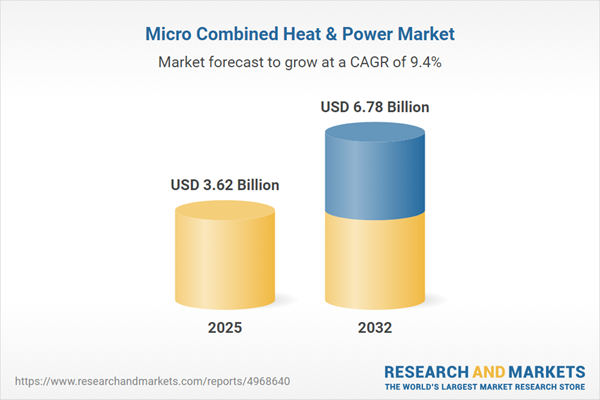Speak directly to the analyst to clarify any post sales queries you may have.
Micro combined heat and power (CHP) systems are reshaping energy generation strategies for forward-thinking organizations. By efficiently delivering both electricity and thermal energy from a single installation, micro CHP solutions support efforts to optimize energy use, enhance operational resilience, and advance sustainability targets.
Market Snapshot: Micro Combined Heat and Power Market Overview
The Micro Combined Heat & Power Market grew from USD 3.31 billion in 2024 to USD 3.62 billion in 2025. It is expected to continue growing at a CAGR of 9.35%, reaching USD 6.78 billion by 2032. Rising demand for decentralized power, robust efficiency improvements, and evolving policy incentives are accelerating adoption across global regions and sectors. This robust expansion reflects the central role of micro CHP in bridging the flexibility of onsite generation with progress toward decarbonization and operational cost management.
Scope & Segmentation of the Micro Combined Heat and Power Market
This comprehensive market research report provides in-depth analysis and forecasts across multiple dimensions:
- Technology Type: Fuel cell technologies—including molten carbonate, phosphoric acid, proton exchange membrane, and solid oxide variants—alongside microturbines, organic Rankine cycles, reciprocating engines, and Stirling engines.
- Application: Commercial, industrial, and residential settings, each with distinct demand profiles and deployment drivers.
- Power Output: Units spanning less than 5 kW, 5–50 kW, and above 50 kW to address diverse facility requirements and spatial constraints.
- Fuel Type: Biogas, diesel, hydrogen, and natural gas systems, each presenting unique supply chain and emissions considerations.
- Distribution Channel: Direct sales and distributor-based models influencing engagement, after-sales support, and customer experience.
- Geography: Detailed coverage of North America (United States, Canada, Mexico), Latin America (Brazil, Argentina, Chile, Colombia, Peru), Europe (United Kingdom, Germany, France, Russia, Italy, Spain, Netherlands, Sweden, Poland, Switzerland), Middle East (United Arab Emirates, Saudi Arabia, Qatar, Turkey, Israel), Africa (South Africa, Nigeria, Egypt, Kenya), and Asia-Pacific (China, India, Japan, Australia, South Korea, Indonesia, Thailand, Malaysia, Singapore, Taiwan).
- Company Profiles: Analysis of leading players such as 2G Energy AG, BDR Thermea Group, Ceres Power Holdings PLC, General Electric Company, Siemens AG, and others.
Key Takeaways for Senior Decision-Makers
- Micro CHP systems integrate on-site power with efficient thermal recovery, increasing energy utilization and supporting both cost-saving and sustainability programs.
- Decentralized power generation using micro CHP enables organizations to bolster grid resilience and manage exposure to energy market volatility.
- Technological advances—especially in solid oxide and proton exchange membrane fuel cells, microturbines, and enhanced waste heat recovery—are driving system performance and operational flexibility.
- Evolving policy and regulatory frameworks, including emissions mandates and incentives, continue to stimulate adoption in developed and emerging markets.
- Strategic partnerships, vertical integration, and alliances between manufacturers and local service providers are strengthening supply chain reliability and after-sales support.
Tariff Impact on the Micro Combined Heat & Power Market
Recent changes to tariff structures, particularly in the United States, target imported components essential to micro CHP systems. These measures have affected supply chain strategies and increased emphasis on securing domestic production capabilities. Manufacturers and integrators are adjusting procurement, exploring local partnerships, and renegotiating service agreements to limit exposure to price fluctuations and maintain continuity in project delivery.
Methodology & Data Sources
This report leverages a rigorous research methodology, combining primary interviews with industry executives and technology developers with extensive secondary analysis from academic publications, industry white papers, and regulatory records. Triangulating qualitative and quantitative data ensures accuracy and actionable insights for stakeholders.
Why This Report Matters
- Provides critical, segmented market intelligence needed for strategic capital planning and partnership decisions within the micro CHP industry.
- Delivers actionable forecasts by technology, application, and geography, enabling leaders to identify emerging opportunities and optimize resource deployment.
- Equips organizational decision-makers with evidence-based analysis on regulatory trends, supply chain shifts, and technology advancements to inform resilient growth strategies.
Conclusion
Micro CHP solutions are emerging as foundational components in the transition to more resilient, efficient, and sustainable energy infrastructures. Stakeholders who align with emerging trends and advance collaboration will capture value as the market matures.
Additional Product Information:
- Purchase of this report includes 1 year online access with quarterly updates.
- This report can be updated on request. Please contact our Customer Experience team using the Ask a Question widget on our website.
Table of Contents
3. Executive Summary
4. Market Overview
7. Cumulative Impact of Artificial Intelligence 2025
Companies Mentioned
The companies profiled in this Micro Combined Heat & Power market report include:- 2G Energy AG
- Axiom Energy Group, LLC
- BDR Thermea Group
- Centrica PLC
- Ceres Power Holdings PLC
- EC POWER A/S
- EDF Group
- Honda Motor Co., Ltd.
- Micro Turbine Technology B.V.
- Siemens AG
- TEDOM a.s.
- Vaillant GmbH
- Veolia
- Viessmann Climate Solutions SE
- Yanmar Holdings Co., Ltd.
- Helbio S.A.
- ATCO Ltd.
- General Electric Company
- HELEC Ltd.
- The GHS Group Ltd.
- Wärtsilä Corporation
- MAN Energy Solutions SE
- Bloom Energy
Table Information
| Report Attribute | Details |
|---|---|
| No. of Pages | 192 |
| Published | November 2025 |
| Forecast Period | 2025 - 2032 |
| Estimated Market Value ( USD | $ 3.62 Billion |
| Forecasted Market Value ( USD | $ 6.78 Billion |
| Compound Annual Growth Rate | 9.3% |
| Regions Covered | Global |
| No. of Companies Mentioned | 24 |









